Re: CPAP and BiPAP?
Posted: Sat Apr 12, 2014 4:26 pm
I contacted Respironics on my question about the discussion, here is the response I received about it. Seems I wasn't as far off as I thought and the seasoned veteran that is well versed in everything may be wrong after all....
Dear Mrs. Connors, Thank you for the interest in the flex family of technology here at Philips. You requested info on the A-flex technology specifically. The inquiry also stated that a discussion of BiPap and AutoCPAP with A-flex was discussed and that there was nothing similar to them. This can be seen as both correct and incorrect. AutoCPAP with A-flex does mimic BiPap as it has a lower exhale pressure. The difference is that BiPap has a set pressure that it is set to, it does not change. The A-flex technology uses a bunch of calculations and info from the machine to automatically set the pressure. You said that your pressure was on a range of 9.5-15 cm h2o with an A-flex setting of 3. You noted that you were informed that the least pressure reduction you would see was 2 cm h2o, this is hard to say but unlikely at 9.5 cm h2o. A pressure minimum of 6 cm h2o is required to have A-flex enabled, this is due to the fact that the reduction can be up to 5cm h2o with the setting of 6 cm h2o and a complete stop of flow and restart would be counter-productive. At higher pressures, it can be even more up to 12 cm h2o lower at exhale over your inhale pressure. The 2 cm h2o does apply in a sense, as it is a maximum of 2 cm h2o between the end and/or stop of your exhale to your inhale pressure. So in your case if you are starting your machine at 9.5 cm h2o the least your pressure will be after exhale completion is 7.5 cm h2o, but during the night the pressures can fluctuate and then if your inhale was at 12 cm h2o your would end the exhale at no less than 10 cm h2o. We have included a picture to show this, the red circle is the end of the exhale, which is no more than 2 cm h2o lower than the last inhale. The blue circle can be from 1-12 cm h2o lower depending on the A-flex setting, pressure, and exhale flow. I do hope this helps to answer your questions, please do not hesitate to contact us again in your need more clarification.
Raymond Smithson

Dear Mrs. Connors, Thank you for the interest in the flex family of technology here at Philips. You requested info on the A-flex technology specifically. The inquiry also stated that a discussion of BiPap and AutoCPAP with A-flex was discussed and that there was nothing similar to them. This can be seen as both correct and incorrect. AutoCPAP with A-flex does mimic BiPap as it has a lower exhale pressure. The difference is that BiPap has a set pressure that it is set to, it does not change. The A-flex technology uses a bunch of calculations and info from the machine to automatically set the pressure. You said that your pressure was on a range of 9.5-15 cm h2o with an A-flex setting of 3. You noted that you were informed that the least pressure reduction you would see was 2 cm h2o, this is hard to say but unlikely at 9.5 cm h2o. A pressure minimum of 6 cm h2o is required to have A-flex enabled, this is due to the fact that the reduction can be up to 5cm h2o with the setting of 6 cm h2o and a complete stop of flow and restart would be counter-productive. At higher pressures, it can be even more up to 12 cm h2o lower at exhale over your inhale pressure. The 2 cm h2o does apply in a sense, as it is a maximum of 2 cm h2o between the end and/or stop of your exhale to your inhale pressure. So in your case if you are starting your machine at 9.5 cm h2o the least your pressure will be after exhale completion is 7.5 cm h2o, but during the night the pressures can fluctuate and then if your inhale was at 12 cm h2o your would end the exhale at no less than 10 cm h2o. We have included a picture to show this, the red circle is the end of the exhale, which is no more than 2 cm h2o lower than the last inhale. The blue circle can be from 1-12 cm h2o lower depending on the A-flex setting, pressure, and exhale flow. I do hope this helps to answer your questions, please do not hesitate to contact us again in your need more clarification.
Raymond Smithson
